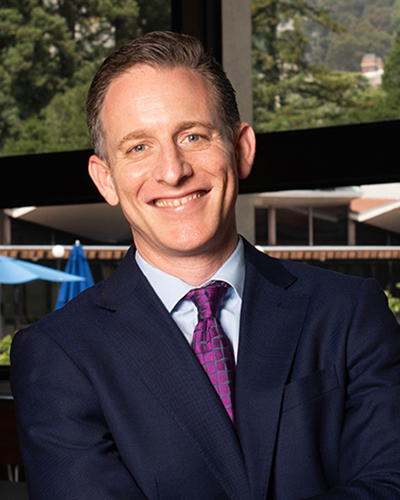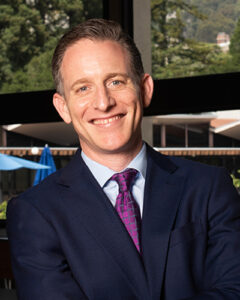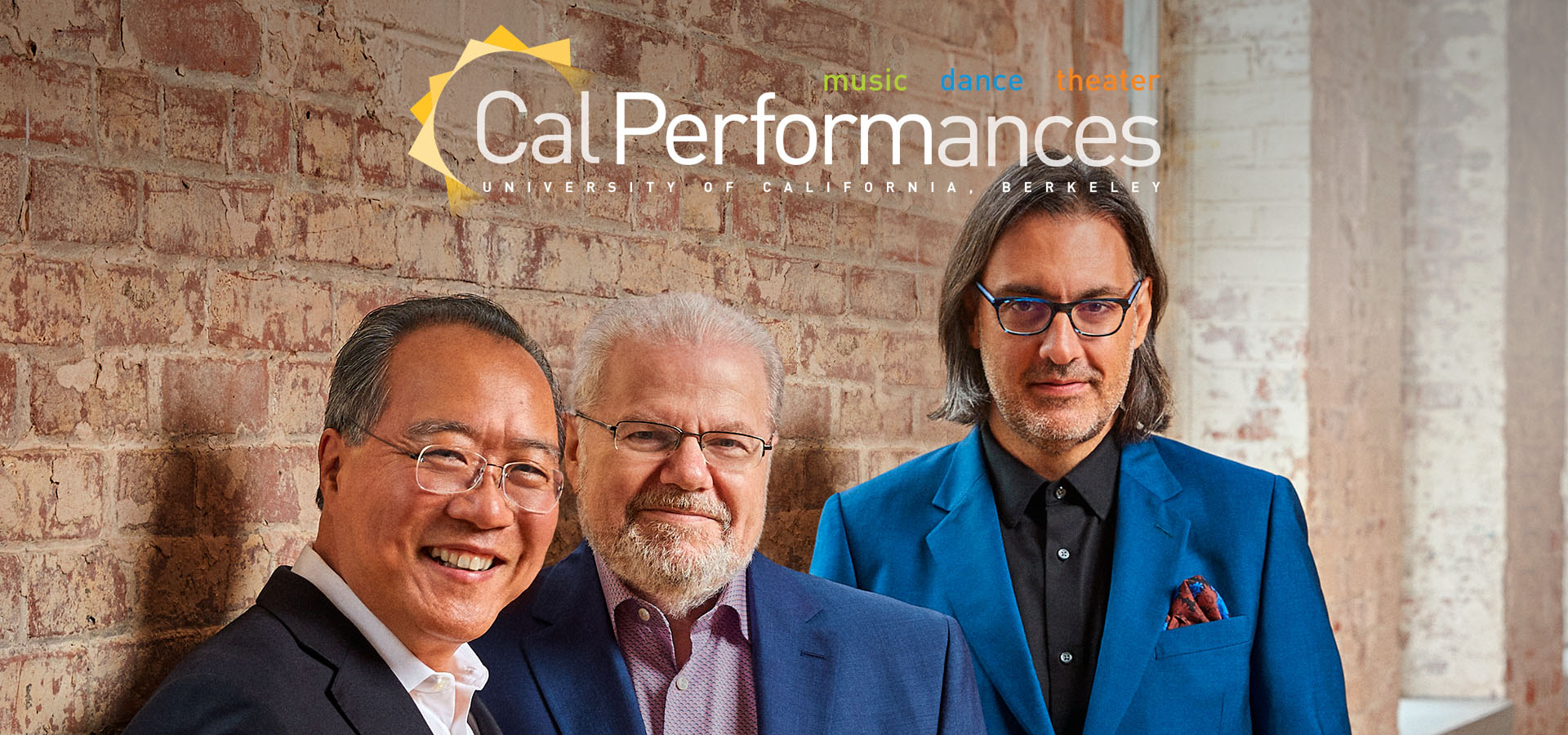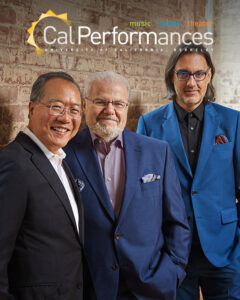Emanuel Ax – Leonidas Kavakos – Yo-Yo Ma
Wednesday, January 25, 2023, 7:30pm
Zellerbach Hall
Emanuel Ax, piano
Leonidas Kavakos, violin
Yo-Yo Ma, cello
opus3artists.com
Run time for this concert is approximately 1 hour and 40 minutes, including intermission, but not including any possible encores.
This performance is made possible, in part, by Sakurako and William Fisher.
From the Executive and Artistic Director

The new year gets off to a brilliant start this month with five performances featuring a host of popular returning artists. The renowned Monterey Jazz Festival on Tour celebrates 65 years of scintillating jazz-making when this year’s super-group hits Zellerbach Hall on January 18. Then, our focus shifts to classical music as we welcome the brilliant mezzo-soprano Joyce DiDonato and her partners Il Pomo d’Oro and conductor/violinist Zefira Valova with EDEN, their new program exploring the majesty, might, and mystery of the natural world. (By the way, the artists’ superb recording of this concert has been nominated for a Grammy Award this year.) The brilliant pianist Joyce Yang serves up a feast of music by composers including Tchaikovsky, Rachmaninoff, and Stravinsky, followed by a true season highlight, a special evening with chamber music superstars pianist Emanuel Ax, violinist Leonidas Kavakos, and cellist Yo-Yo Ma. Finally, the wonderful Takács Quartet returns for its second Cal Performances program this season, featuring music by Britten, Bartók, and Dvořák.
And that’s just the start of what we have planned for 2023. From now until May, when we close our season with the Bay Area premiere of Octavia E. Butler’s powerful and prescient opera Parable of the Sower and a long-awaited recital with international dramatic soprano sensation Nina Stemme—we have a calendar packed with the very best in the live performing arts.
And what a schedule! Dozens of remarkable events, including the return of the legendary Vienna Philharmonic Orchestra under conductor Christian Thielemann (in his Bay Area debut); the beloved Mark Morris Dance Group in Morris’ new The Look of Love: An Evening of Dance to the Music of Burt Bacharach; and the US premiere of revered South African artist William Kentridge’s astonishing new SIBYL (part of an exciting campus-wide residency with this singular artist).
Upcoming Illuminations programming will continue to take advantage of Cal Performances’ unique positioning as a vital part of the world’s top-ranked public university. Over the coming months, we’ll be engaging communities on and off campus to examine the evolution of tools such as musical instruments and electronics, the complex relationships between the creators and users of technology, the possibilities enabled by technology’s impact on the creative process, and questions raised by the growing role of artificial intelligence in our society.
This concept of “Human and Machine” has never been so pertinent to so many. Particularly over the course of the pandemic, the rapid expansion of technology’s role in improving communication and in helping us emotionally process unforeseen and, at times, extraordinarily difficult events has made a permanent mark on our human history. Throughout time, our reliance on technology to communicate has—for better and worse—influenced how we understand others as well as ourselves. During this Illuminations season, we will investigate how technology has contributed to our capacity for self-expression, as well as the potential dangers it may pose.
Some programs this season will bring joy and delight, and others will inspire reflection and stir debate. We are committed to presenting this wide range of artistic expression on our stages because of our faith in the performing arts’ power to promote empathy. And it is because of our audiences’ openness and curiosity that we have the privilege of bringing such thought-provoking, adventurous performances to our campus. The Cal Performances community wants the arts to engage in important conversations, and to bring us all together as we see and feel the world through the experiences of others.
Please make sure to check out our brochures and our website for complete information about upcoming events. We can’t wait to share all the details with you, in print and online.
Happy New Year from Cal Performances!
Jeremy Geffen
Executive and Artistic Director, Cal Performances
 The new year gets off to a brilliant start this month with five performances featuring a host of popular returning artists. The renowned Monterey Jazz Festival on Tour celebrates 65 years of scintillating jazz-making when this year’s super-group hits Zellerbach Hall on January 18. Then, our focus shifts to classical music as we welcome the brilliant mezzo-soprano Joyce DiDonato and her partners Il Pomo d’Oro and conductor/violinist Zefira Valova with EDEN, their new program exploring the majesty, might, and mystery of the natural world. (By the way, the artists’ superb recording of this concert has been nominated for a Grammy Award this year.) The brilliant pianist Joyce Yang serves up a feast of music by composers including Tchaikovsky, Rachmaninoff, and Stravinsky, followed by a true season highlight, a special evening with chamber music superstars pianist Emanuel Ax, violinist Leonidas Kavakos, and cellist Yo-Yo Ma. Finally, the wonderful Takács Quartet returns for its second Cal Performances program this season, featuring music by Britten, Bartók, and Dvořák.
The new year gets off to a brilliant start this month with five performances featuring a host of popular returning artists. The renowned Monterey Jazz Festival on Tour celebrates 65 years of scintillating jazz-making when this year’s super-group hits Zellerbach Hall on January 18. Then, our focus shifts to classical music as we welcome the brilliant mezzo-soprano Joyce DiDonato and her partners Il Pomo d’Oro and conductor/violinist Zefira Valova with EDEN, their new program exploring the majesty, might, and mystery of the natural world. (By the way, the artists’ superb recording of this concert has been nominated for a Grammy Award this year.) The brilliant pianist Joyce Yang serves up a feast of music by composers including Tchaikovsky, Rachmaninoff, and Stravinsky, followed by a true season highlight, a special evening with chamber music superstars pianist Emanuel Ax, violinist Leonidas Kavakos, and cellist Yo-Yo Ma. Finally, the wonderful Takács Quartet returns for its second Cal Performances program this season, featuring music by Britten, Bartók, and Dvořák.
And that’s just the start of what we have planned for 2023. From now until May, when we close our season with the Bay Area premiere of Octavia E. Butler’s powerful and prescient opera Parable of the Sower and a long-awaited recital with international dramatic soprano sensation Nina Stemme—we have a calendar packed with the very best in the live performing arts.
And what a schedule! Dozens of remarkable events, including the return of the legendary Vienna Philharmonic Orchestra under conductor Christian Thielemann (in his Bay Area debut); the beloved Mark Morris Dance Group in Morris’ new The Look of Love: An Evening of Dance to the Music of Burt Bacharach; and the US premiere of revered South African artist William Kentridge’s astonishing new SIBYL (part of an exciting campus-wide residency with this singular artist).
Upcoming Illuminations programming will continue to take advantage of Cal Performances’ unique positioning as a vital part of the world’s top-ranked public university. Over the coming months, we’ll be engaging communities on and off campus to examine the evolution of tools such as musical instruments and electronics, the complex relationships between the creators and users of technology, the possibilities enabled by technology’s impact on the creative process, and questions raised by the growing role of artificial intelligence in our society.
This concept of “Human and Machine” has never been so pertinent to so many. Particularly over the course of the pandemic, the rapid expansion of technology’s role in improving communication and in helping us emotionally process unforeseen and, at times, extraordinarily difficult events has made a permanent mark on our human history. Throughout time, our reliance on technology to communicate has—for better and worse—influenced how we understand others as well as ourselves. During this Illuminations season, we will investigate how technology has contributed to our capacity for self-expression, as well as the potential dangers it may pose.
Some programs this season will bring joy and delight, and others will inspire reflection and stir debate. We are committed to presenting this wide range of artistic expression on our stages because of our faith in the performing arts’ power to promote empathy. And it is because of our audiences’ openness and curiosity that we have the privilege of bringing such thought-provoking, adventurous performances to our campus. The Cal Performances community wants the arts to engage in important conversations, and to bring us all together as we see and feel the world through the experiences of others.
Please make sure to check out our brochures and our website for complete information about upcoming events. We can’t wait to share all the details with you, in print and online.
Happy New Year from Cal Performances!
Jeremy Geffen
Executive and Artistic Director, Cal Performances
About the Performance
BEETHOVEN’S 4TH SYMPHONY AS PIANO TRIO
For someone so often perceived as the embodiment of the revolutionary musician, it is surprising how rarely Beethoven actually broke the rules. His true genius wasn’t in rebelling against his predecessors Haydn and Mozart but rather in expanding their language to reach new, uncharted territories. It enabled him to take the revolutionary ideals he fervently believed in—freedom, individual agency—and reflect them in music without burning down the house.
The Fourth Symphony is a case in point. Nestled between two symphonies that are far more famous and dramatic, it can seem less audacious. But it is a prime example of how Beethoven used existing concepts to express something entirely new.
From the start, Beethoven appears to follow Haydn’s model of opening a symphony with a slow, weighty introduction. But “introduction” is a misnomer here—this music doesn’t exactly set the stage for us. Quite the opposite, in fact, it is daringly abstract: just bare, falling intervals over a diaphanous drone. (You may hear Mahler’s First Symphony in it. Or Star Trek music. Either way, you are absolutely correct!) We are being led blindly through dark, amorphous space with nothing to indicate the path forward. But just as we hit an impasse, with a sudden chord and a violin flourish—like a burst of sonic light—the music breaks free and sets the rest of the movement on course with irresistible energy. It’s an unforgettable moment, possibly inspired by Haydn’s “let there be light” from The Creation, but also fundamentally different: for Beethoven, the triumph of order over chaos is not a religious sentiment but an idealistic, political one. And as if to reiterate that it’s never guaranteed, the music later slides again into that formless abyss, now placing the mysterious drone down in the darkest depths, threatening to devour all other notes. But as if struggling against its pull, the familiar flourishes in the strings that had heralded the moment of freedom build up again, toward an even brighter sonority than before. That’s the one element Beethoven keeps going back to more than anything else in the first movement, which he ends with a surge of optimism that is simply intoxicating, the glow of which prevails over the rest of the symphony.
Chamber versions of orchestral music used to be fairly common during the 19th century. But conveying a Beethoven symphony scored for dozens of instruments through the intimate, more conversational idiom of a piano trio is a bit like translating a truly great novel. To try and illuminate his explosive, timeless ideas through a whole new lens is nothing short of thrilling.
—Shai Wosner
Ludwig van Beethoven
Symphony No. 4 in B-flat major, Op. 60
Arr. by Shai Wosner
Piano Trio in B-flat major, Op. 97, Archduke
As the concert repertoire grew through the 19th century, so did the demand for music that could put the family piano to use. In those days before recordings, orchestral works made their way into music lovers’ homes via transcriptions. Versions for piano, often for piano four-hands, opened the repertoire to those who could play and to those who preferred just to listen. Transcriptions also guaranteed composers and publishers steady sales for their symphonies and overtures, no orchestra required. Nor were transcriptions confined to the home. Franz Liszt transcribed all nine Beethoven symphonies, keyboard versions made for virtuosos and the concert hall, made also for those who wanted to know these works but who might never have the chance to hear an orchestra perform them.
Transcriptions of orchestral music, while not limited to the keyboard, all have the common purpose of helping that music find a wider audience. And the best transcriptions, though faithful to the source, are also original. In fitting an orchestral work to a smaller ensemble, the transcriber reduces the source—in the sense that a sauce is reduced, concentrating rather than diminishing it.
The transcriber weighs how to channel the interweaving lines of an orchestra into those of a chamber ensemble, and how to assign, to a group of three or four, the many colors of the many instruments in an orchestra’s many sections. Depending on the transcriber’s choices and emphases, the result can reveal new aspects in music you thought you knew—music such as a Beethoven symphony, for example, whose familiarity can erode its contours, along with its sense of surprise. It is this sense of surprise, this sense of Beethoven, that the transcriber attempts to restore. This evening we hear pianist Shai Wosner’s version of the Beethoven Fourth Symphony for piano, violin, and cello.
Beethoven completed his Fourth Symphony in the fall of 1806, and it shares qualities with other music he composed around that time, such as the Fourth Piano Concerto and Violin Concerto. These compositions, says his biographer Maynard Solomon, “appear to have taken on certain qualities of a magnified chamber music,” given “their temporary retreat from exalted rhetoric into a more lyrical, contemplative and serene style.” The symphony does indeed bear temperamental resemblances with the concertos, though in a composer of Beethoven’s breadth the differences in concurrent compositions are also notable. The Fourth Symphony was composed almost alongside the Fifth, whose only tranquil moments unfold in its lovely slow movement.
Which is not to say the Fourth and Fifth symphonies are total opposites. If you know the Fifth, you will recognize how closely the tense, sotto voce opening of its third movement resembles the Fourth Symphony’s hushed introduction. These opening pianissimo bars of the Fourth move as deliberately as a cat focused on its prey, the music confined to the dark minor until it leaps forward in a fortissimo explosion of B-flat major and the tempo’s switch is thrown from adagio to allegro vivace. From here on out, the movement thrusts ahead at high speed and with manic energy.
Beethoven’s work includes pages that are among music’s most thrilling, but he also composed slow music of a beauty that defies reality. The cantabile passage that opens the symphony’s second movement is such music, but what transforms this passage from pretty to ravishing is the accompanying string figure, sounding first as two notes, then three, and which will rarely be absent throughout the movement. The scherzo and finale are cousins—that vivace tempo marking for the scherzo could apply as well to the concluding allegro. Together, they recall the spirit of the first movement. It is all about celebrating life, remarkable when you consider that only four years earlier, in his Heiligenstadt Testament, Beethoven had disclosed his growing deafness and confessed that he had considered suicide. He rejected that path because, he implied, he felt compelled to produce what no one else could. In Beethoven, the work always justifies the ego.
Given Beethoven’s omnipresence on concert programs and his mastery of almost every genre, we can imagine him at his desk morning to night, grinding out the next masterpiece. But genius guarantees no immunity from fallow stretches, and ill health and hangovers—regular facts of Beethoven’s adult life—undermine inspiration and the work ethic. Beethoven’s Opus 97, his last trio for piano, violin, and cello, was born during a dry spell and was his only major work of 1811. Still, when he returned to the sketches he had made the previous year and set his attention to the trio, he completed it in just over three weeks, from March 3 to March 26. Beethoven’s story seems always a fusion of the wretched and the miraculous, proof that the grand can coexist with the miserable, the reason (embodied in the music) we keep returning to him—the reason, that is, for his omnipresence.
The Archduke Rudolph, for whom Opus 97 is named, was Beethoven’s student and patron. The two men admired each other, and Rudolph sparked an uncharacteristic warmth in Beethoven, so much so that the composer dedicated more works to him than to anyone else, 15 of them, important music that includes the Fourth and Fifth piano concertos, the Missa solemnis, and, of course, this trio.
If you were the sort of person to invent lyrics for the concert hall’s big tunes—mnemonic devices for the Brahms First, say, or the Schubert Fifth—you would surely be tempted to find words for the opening of the Archduke Trio. The solo piano outlines one of music’s great melodies before violin and cello join in. Echoes of this noble first theme are then woven into the lighthearted second subject, and a satisfying sense of rightness ends the exposition, which Beethoven repeats almost verbatim, the better to lodge the singable themes in our memory. The development includes an extraordinary section in which pizzicato strings mimic the plucked keys of the piano, followed by a passage in which the various lines seem to unravel, to be tied back into place with a reprise of the first theme. The recapitulation leads to a conclusion that embodies what Maynard Solomon calls the trio’s “measured nobility of rhetoric,” one of those indefinables that can cast a kind of spell over a listener, a spell whose source is Beethoven’s “development of broad, moderately paced, and flowing melodies,” which create “a sense of calm [and] spaciousness.”
Beethoven’s scherzos generally unfold in three parts, the opening and closing “A” sections surrounding a middle “B” section. Here the cello and violin, then piano, start the “A” section with a country dance, all high spirits until “B.” With an abrupt mood shift, an oddly disturbing darkness intrudes and our ears feel suddenly abandoned, the tonal center having dropped out. This lasts for only a few measures. No sooner do high spirits return, however, when darkness falls again—again just briefly—prelude to another episode of alternating light and dark. With the reappearance of the opening dance, we seem at last to have entered the concluding “A” section. But Beethoven will not let us off so easily and ventures yet again into the indeterminate area of “B” until a resolute consonant gesture seals the movement.
Now comes one of Beethoven’s great adagios. The theme, on which four variations are built, is a dreamlike song. Piano and cello take the lead in the first variation, followed by violin, the strings singing long lines below the quietly rapturous keyboard. Violin and cello introduce a jaunty tune in variation two, first playful and then yearning. With the piano in the lead, the pace accelerates in variation three. In the fourth variation, strings enter a long rhapsody while the piano marks time. The coda opens with a return of the main theme, though the pace is slower than at the outset while the theme’s shapes are explored, its risings and fallings. Soon we are back home, in the midst of the music that opened this movement. That music grows ever quieter, fading, yet it heads not toward silence but instead straight to the finale, whose raucous first bars burst the mood just established. This is Beethoven’s brand of humor, verging on the boorish. He has no time, however, for what you or I think of his manners. Because now he gives the players the opportunity to display their delight in music-making, and this is where they get to have fun—conscious, perhaps, that they are doing more than bringing great music to life. They are also entertaining an audience.
—Larry Rothe
Larry Rothe writes about music for Cal Performances and San Francisco Opera. His books include For the Love of Music and Music for a City, Music for the World. Visit larryrothe.com.






